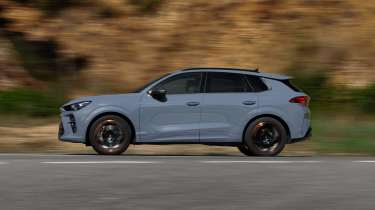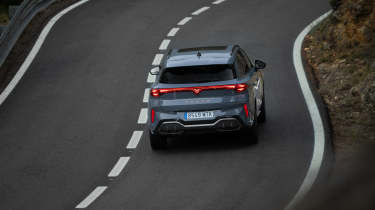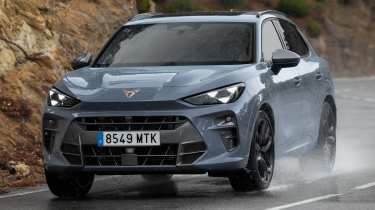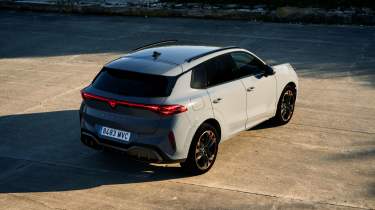Cupra Terramar 2025 review – a family SUV with a hot hatch heart
With a bespoke chassis tune and a 261bhp 2-litre engine option, the Terramar is pitched as a fun, fast alternative to the likes of the Volkswagen Tiguan. Does it deliver?
Cupra is stuck between a rock and a hard place. On the one hand, it’s a fresh, sporty, quintessentially Spanish brand grown out of a line of hot Seats that has real style and performance potential. On the other, it’s one among a few in the Volkswagen Group stable tasked with imbuing shared underpinnings with what attitude and style it can.
We’d hoped for a sports car when Cupra became a brand all of its own in 2018 but so far, we’ve seen a raft of hatches, EVs and SUVs. Of the latter, the Terramar is one of its newest, riding on the MQB Evo platform, and a move by Cupra to ‘grow up’ but ‘without losing our rebellious and challenger spirit’, according to CEO Wayne Griffiths.
Let’s not dismiss it out of hand, though, because there’s good stuff here. It’s available in VZ form – short for Veloz, Spanish for fast – with a potent turbocharged four-cylinder or plug-in hybrid powerplants depending on your tastes. There’s also the option of big brakes, Cupra specific handling tuning and stability control you can turn off.
In typical Cupra style, it also looks pretty sharp, but do the dynamics back that up to make the Terramar a worthy car all of its own, or does it do the century-old race track and Spanish Balearic Sea overlook to which it owes its name a disservice?
Engine, gearbox and technical highlights
Okay, what about the oily bits? As above, the Terrama rides on the MQB Evo platform, and comes with a familiar choice of Volkswagen-sourced engines. That means a 148bhp 1.5-litre eTSI at the bottom of the range, a 2-litre four-pot with 201bhp, or a similarly powerful 1.5-litre hybrid. Step up to the VZ trim and more potent options are available – a 261bhp Golf GTI-derived four-cylinder or a 268bhp hybrid. The latter uses a 128bhp 1.5-litre TSI augmented by a 25.7kWh (19.7 usable) battery and electric motor for 268bhp in total. Torque is identical between the two at 295lb ft, though the PHEV delivers it sooner. As you’d expect, the ICE-only car is lighter (1750kg at the kerb vs 1904kg) and therefore, a chunk more sprightly, even if it’s a little down on power by the numbers. It hits 62mph in 5.9sec, as opposed to the 7.3sec the PHEV manages.
Cupra says all Terramars have what would be the equivalent of sport suspension on other Group cars on the same platform, meaning it rides 10mm lower, with two-valve, dynamic chassis control dampers. There are new control arms and uprights at the front that allow more negative camber, designed to improve steering response. The wheels are 19-inch as standard in VZ spec, with 255mm tyres. There’s also the option of Akebono performance brakes, with six-piston calipers and 375mm discs up front, instead of the standard 340mm items.
Performance, ride and handling
It’s not exactly a thriller, or as dynamic as the most focused version of Cupra’s Formentor, but the Terramar is a neat-handling, perfectly agreeable SUV to drive. It has good turn-in, solid body control and a stable balance, albeit one that leans towards safety rather than fun.
The adaptive damping, with its 15 levels of adjustment, gives the Terramar more breadth to work with bumpy British roads. It’s a relaxed, easy going car in the softest settings, but the body is free to heave and float over the surface, which can be a little unsettling. Moving the adjustment slider towards the middle Performance setting helps with this. Stiffening the dampers to Cupra mode tightens things up further, which gives the Terramar more poise on smooth roads but can have it jostling around and feeling too reactive on pockmarked tarmac. In general, the Terramar isn’t as keen and responsive as a Formentor, and feels more comfortable at a swift pace than a rapid one.
The engine and transmission are familiar, with the 2-litre 261bhp four-pot being the same EA888 unit you’ll find in a Golf GTI, mated to a seven-speed DSG. It’s far from the most tuneful or rev happy engine, and the Terramar’s extra weight swallows some performance compared to the Golf, but it’s strong enough to haul along at a decent pace. The Akebono brakes have the power to match, arresting the Terramar from high speed with ease. There’s good travel in the pedal, with the right response and calibration too. All over, the 2-litre Terramar is well resolved for what is a family-sized, Tiguan-related SUV.
If only the same could be said of the hybrid, which is marred by the integration of its regenerative braking system, its apologetic powertrain and the added weight. There’s good engine braking effect when letting off from speed but as you get to a slow enough speed to start applying the brakes, there’s an unsettling dead zone at the top of the pedal. Proper braking at higher speeds isn’t so bad but there’s still a step in feel.
Then there’s the powertrain itself, which just doesn’t have the character befitting its billing as the most powerful Terramar variant. The electric range is impressive, indicating 55 miles of the stated 62 available at the start of our drive and you can set it to prioritise electric drive and decide how much recovery you want via the touch screen. You can also DC charge the Terramar PHEV at up to 50kW. The electric motor adds a degree of potency and response low down – with max torque arriving from 850rpm as opposed to 1650rpm.
But it doesn’t have the feel of a performance powertrain, with the 128bhp 1.5-litre TSI sounding very out of depth, partly because it’s managed poorly by the six-speed transmission (the 2-litre uses the seven-speed). The six-speed is sluggish, almost to the point of not resembling a twin-clutch. The handover between electric and ICE is smooth enough, though prods of the accelerator call the 1.5-litre engine into action quite unceremoniously.
It just doesn’t seem right, even down to the downright weird sound augmentation, which in Cupra mode – selectable via the Cupra button on the steering steering wheel – sounded like a big American diesel V8 feeding a slurring CVT. Though it gave us a good laugh to begin with, that probably wasn’t the intention… A far cry from the splash of chirruping turbocharged theatre mixed in with the gruff exhaust vocals of the 2-litre, though the less intense ‘Performance Mode’ was fine.
The added weight affects everything, from the steering, to the handling and confidence you have at speed, feeding into the overall sense that the PHEV is far from all the Terramar can be. Good for company car tax reasons and convenient with the electric element it may be, but it doesn’t come close to the 2-litre to drive.
MPG and running costs
The VZ hybrid will be cheaper to run, however. From a full charge it can drive for 72 miles on electric power, so if you’re able to top up the battery at home, you can carry out most journeys without waking the engine. But don’t get too excited by the official 666.7mpg figure – if you don’t plug-in regularly and drive on longer trips you won’t get near that. On paper the less powerful 201bhp plug-in hybrid is even more efficient, with a claimed 683.9mpg.
The 261bhp 2-litre, meanwhile, achieves 33.6mpg on the WLTP cycle. In the lower 201bhp state of tune that rises to 37.4mpg, with the 1.5-litre eTSI being substantially more efficient and rated at 47.4mpg.
Given that much of the Terramar’s mechanicals are shared across the wider Volkswagen Group, consumables and spares should be in plentiful supply. However, replacing Cupra-specific parts – such as the optional Akebono brakes – is likely to cost more than conventional items.
Design, interior and technology
The Cupra Terramar’s aggressive style renders the likes of the Volkswagen Tiguan and Skoda Kodiaq sturdy and staid. It does look good, with the ‘wave’ signature on the D pillar designed to reflect the ‘Mar’ – sea in Spanish – in the Terramar’s name. The new three-light signature at the front now features Matrix LED Ultra tech that can dance and project, beyond simply being on or off. It seems Audi doesn’t get to keep all the really good stuff.
Inside the Terramar is pleasant in appearance, with the driver-centric layout incorporating more of that ‘wave’ motif, while positioning the touchscreen – and the various vital controls hidden within – closer to the touch and closer to your line of sight. That makes the job of navigating it on the move less precarious. Happily, the steering wheel still has all physical controls, too. That screen is the now ubiquitous 12.9-inch item seen in most Cupras, Skodas and VWs. It’s responsive enough and Cupra’s revised UI is intuitive. Apple CarPlay and Android Auto are a given. There’s also a head-up display that’s informative but not too invasive.
All the bronze trim highlights in the VZ First Edition we drove are distinctive, as they are on all Cupras. The ingot-like door handles deserve a special mention. Interior ‘characters’, as Cupra calls them, range from Deep Ocean – dark blue, featuring recycled marine plastics, Moon Light, featuring 73 per cent recycled materials and High Canyon, featuring plant-tanned leather. Beyond the waxy leather seats however, there’s a sense that everything’s not quite to the highest quality – to the touch and to look at. It’s roomy enough in the back, if not quite as airy as some family SUV rivals, especially if you don’t get the panoramic roof. A note of caution too, that the PHEV drops boot capacity from give or take 600 litres, to less than 500 litres.
Price and rivals
The cheapest Terramar is the 1.5-litre eTSI model in V1 spec, which comes in at £38,995. The price ramps up quickly from there, with the 201bhp version being £43,460 and the base plug-in hybrid costing £44,535. The more powerful engines – the 261bhp petrol and 268bhp hybrid – are only available with VZ models, costing £47,855 and £47,410 respectively. A point to note: the big Akebono brakes are an option with a big price, £2035, though adaptive dampers are standard on all VZs. Toys like the top view camera, head-up display and the 20-inch wheels, among a few other useful bits, come with the range-topping VZ2 spec, for about £3000 extra.
Cupra will tell you the Terramar doesn’t overlap with cars like the Volkswagen Tiguan and Skoda Kodiaq, but the truth is, both these are available with similar powertrains – including the 261bhp Golf GTI motor. The Kodiaq vRS packs this in a larger, seven-seat package for £53,690, while the Tiguan R-Line comes in at £50,340 with the same engine.
Really, there aren’t many rivals of its size that approach the job of engaging in the same way so in a sense, it’s in a class of one. In terms of normal family SUVs, it’s in the weeds, with everything from the Kia Sportage, to the Ford Kuga and Hyundai Tucson joining the Terramar and its other Group siblings.






